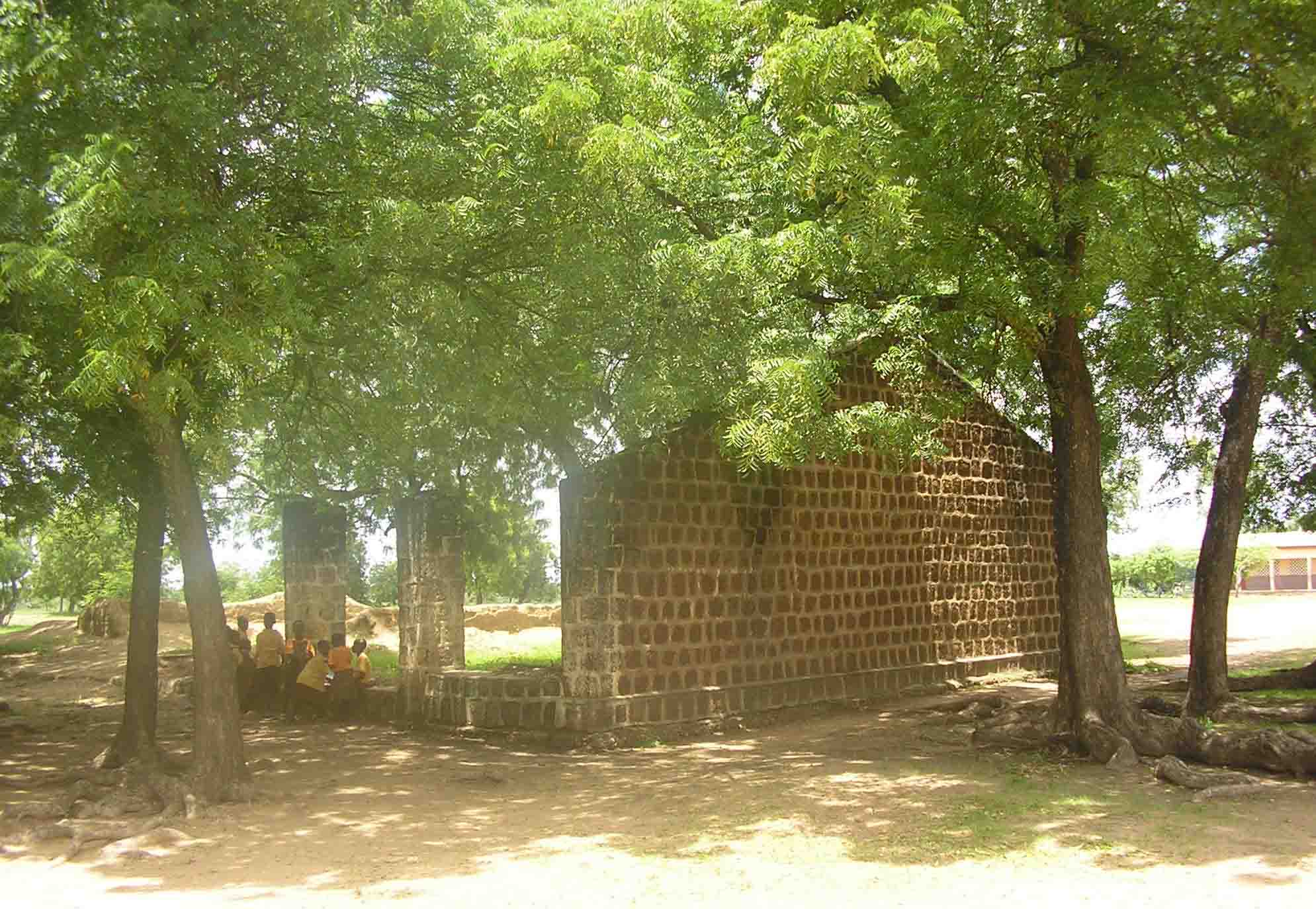
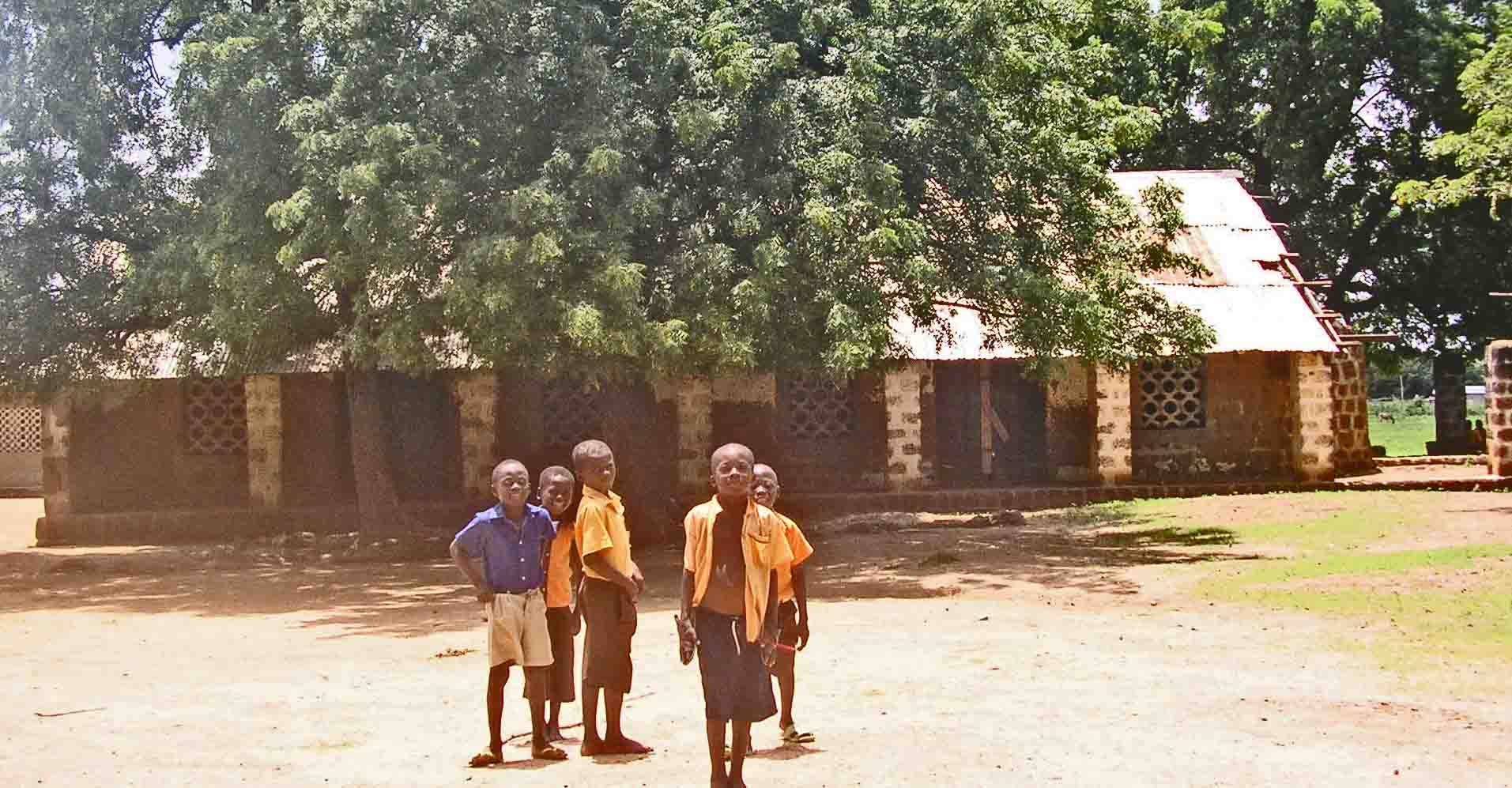
left: Remains of one of the original classroom blocks; right: One of the original stone-built classroom blocks
Ghanatta Ayaric
OUR FIRST FORMAL SCHOOLS
 |
 |
|
left: Remains of one of the original classroom blocks; right: One of the original stone-built classroom blocks |
|
1. Sandema Primary Boarding School (Old Primary)
Sandema Primary Boarding School, popularly called Old Primary today, was the first formal school in Bulsa. It was opened on May 12, 1936. The six years of primary education consisted of Class I, Class II, Class III, Standard I, Standard II and Standard III. On completing Standard III, pupils who passed their exams continued to Standard IV, V, VI and VII at Tamale Middle Boarding School, the only middle boarding school in the Northern Territories at the time.
Teacher Brown Abakisi (retired), a third batch student of the school confirmed my late father’s information that in its first years, Sandema Primary Boarding School was attended mostly by the children of chiefs and sub-chiefs, which explains why some of the school’s first pupils, who later became the first Bulsa teachers and public servants, bear names of past Bulsa chiefs and sub-chiefs:
|
First Pupils of Sandema Primary Boarding School
|
|
Atiriba Azantilow:
later professional teacher in Kanjaga, Wiaga and other places Akantigsi Afoko: MP under Nkrumah 1951-1966 Asianaab Afoko: in 2013 elder of all Ayieta-bisa, living in Bolgatanga Akanyono Atokwie (Sandema) Akanjambudai Apinpanta Aseblanya Atiim Adavari Amaami Angabe Asoalla (Kanjaga): relative (son?) of Rattray's main Bulsa informant Fuseini Mallam Aniekbadek (Kanjarga) Ayuekanbey Adangabe (Kadema): professional teacher; later: Regional Director of Rural Development and Cottage (Cotton?) Industries Akanyaaniong Adangabe (Kadema) Afulang Anisomyaansah: later chief of Siniensi Ben Anisomyaansah (Siniensi) Syme Ajimgbaruk (Siniensi) Agalga: senior brother of the father of Lawyer James Agalga, the present Bulsa North MP Asangalisa: later chief of Chuchulga, uncle of Agnes Asangalisa-Chigabatia, ex- Bulsa North MP Ajuewen /Anyewen (SP of school), Abanamaku (Doninga), Abonbinanya Awulley: father of tNorbert Awulley, he current Bulsa North DCE, Abanyiagaba (Wiesi), Awonbotemi (Bachonsa) Akanbong: brother of Dr. Akanbong (Fumbisi) Akanpaanab Ayaric (Gbedema): father of the author |
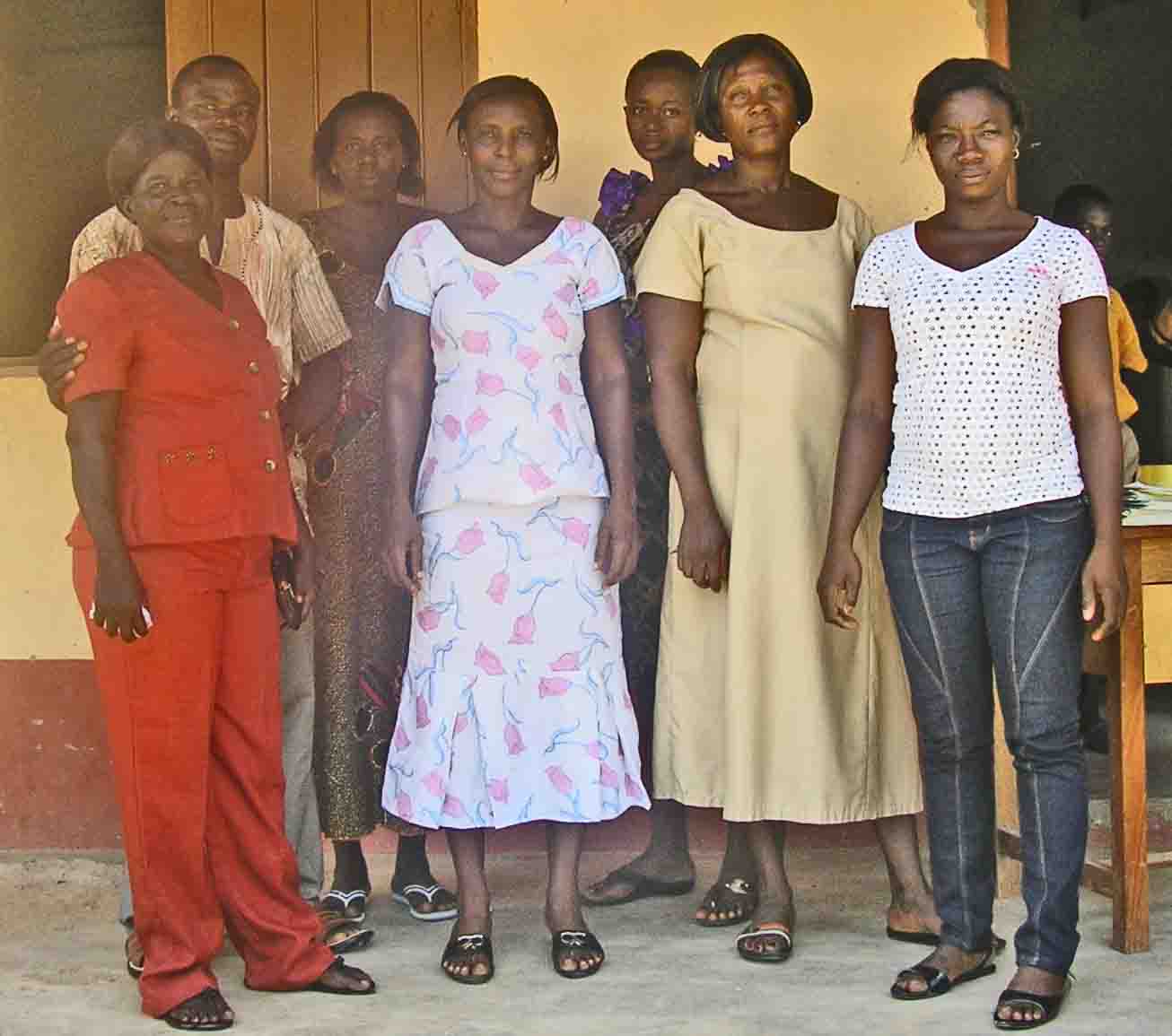 |
| Staff of Sandema Old Primary 2012 |
It was not a plot by the chiefs to monopolize the white man’s knowledge. In fact, some chiefs were reluctant to send their children, but the colonial authorities made it clear to them that they were obliged to. They were to show example by being the first to send their children to school. How could they convince their subjects that formal education was good if they didn’t send their own children to school?
The first batch of thirty-six pupils was taught by an Achimota-trained teacher from Wiaga called Anyasuikbey. Mr Anyasuikbey, the son of a colonial policeman, must have had his elementary education in either Tamale or elsewhere outside the North given the fact that there were no schools in Bulsa then. He was the only teacher in the first year of the school’s existence.
Unfortunately, the early years of the school cannot be reconstructed in detail as there is little information available.
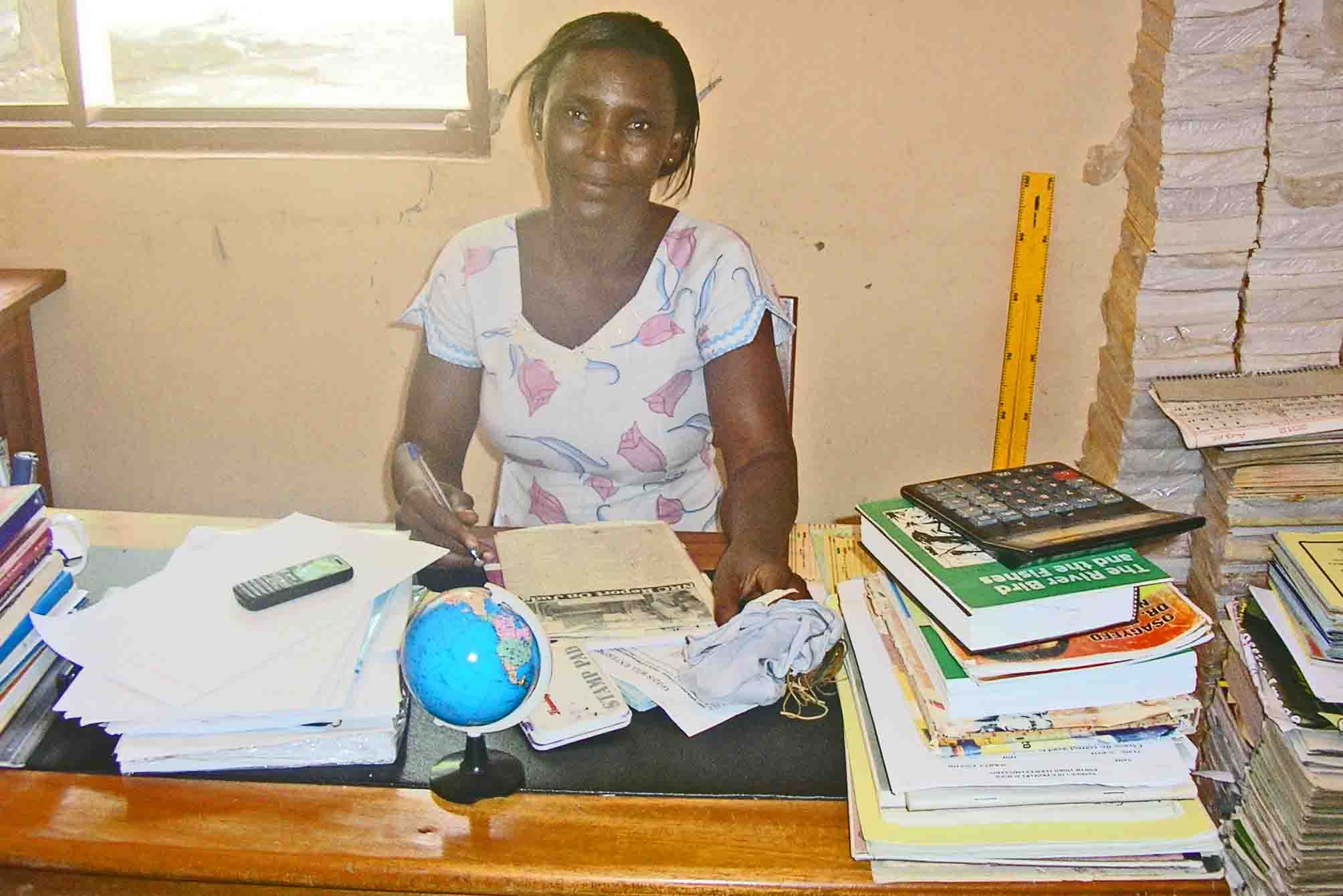 |
|
Mrs. Patience Adjabuni, current headmistress of Old Primary |
I visited the school in July 2012 and was privileged (thanks to the headmistress, Mrs. Patience Adjabuni) to go through the log books. The pages containing information on the school’s first 12 years are missing. One or two gaps in the “missing” are filled in here with entries Dr. Franz Kröger found at the National Archives in Accra. They were written and signed in 1939 by British officers whose names couldn’t be deciphered.
1939 NAG 63/5/8 Informal Diary of Navrongo District
Thursday, 1st June:
6. Went to Sandema to-day to look into the matter of the school diets which Spafford seems to think is not sufficient (he came away with the impression that the children were under-nourished).
7. I must say that I could not see much sign of under-nourishment amongst them but the diet sheet I compiled a few months ago was not being adhered to for the simple reason that some of the things are unobtainable now. The teacher does not seem to have had the sense to substitute when a certain article cannot be obtained (c.f. if no fish substitute meat). I got on to everyone concerned about this diet matter and impressed on them all including the Chief, the necessity for keeping up the standard of feeding of the children.
8. I personally believe that what has prompted Spafford to feel that the children are under-nourished is the fact that Miss Appleyard, I believe, when she went to Sandema said afterwards that they had not food there. She may have been referring to remarks made as to this being the lean time of the year on the other hand she may not, but in any case not much notice need be taken of what she says for her statement that 18 of the Sandema children are still in the infant classes is sheer “bunk”. From all the reports we have had from the Education Dept. staff Sandema is well up to average in progress.
The school’s first log book has signs of the ravages of age. Its pages are not in good condition, but the entries and reports in them are quite detailed and informative, throwing some light on life in the school and, and to extent, in Sandema at the time.
|
First Teachers of Sandema Primary Boarding School |
|
Abu
Gariba: later the Buli teacher of Prof. Schott and the translator of one of
the first publications in Buli, namely the Christmas gospel (though Abu
Gariba is a Muslim). Abu Gariba is now living in Tamale. J.A. Salaam Amami Angabe Anagela Akuri, Akanpaanab Ayaric: See article in BULUK 7 Tatoo Kanbonaba: brother of the late Mathew Kanbonaba... see article in Events, June 24th, 2012 BULUK 7 Aseblanya Atiim Ayuekoruk Atiriba Azantilow Adansegri Asoalla: relative (son?) of Rattray’s main informant, Sergeant Asoalla (see photo Rattray 1932, p. 398) Agalga: Father of ... Bulsa North MP and Deputy Minister of Interior under President Mahama, cf. Events, December 7th, 2012, BULUK 7 Awulley: Father of Norbert Awulley, current DCE of Bulsa North Leander Amoak (1918-1983): see his life-story in BULUK 3, p. 18-20; main informant of Franz Kröger Asueme: For his hand-written life-story see Materialien - 8. Life stories - Asueme Margaret Abaanamkame Azantilow Raphael Adiita: headteacher of Sandema Boarding School, co-operator of Prof. Schott (1988-89) J. Kwallimgjam: Akobirika: Thompson Akaboka Azinab: Aluk Anatey Akanbong: senior brother of Dr. Akanbong Abobtey Anayeng Akisikpak |
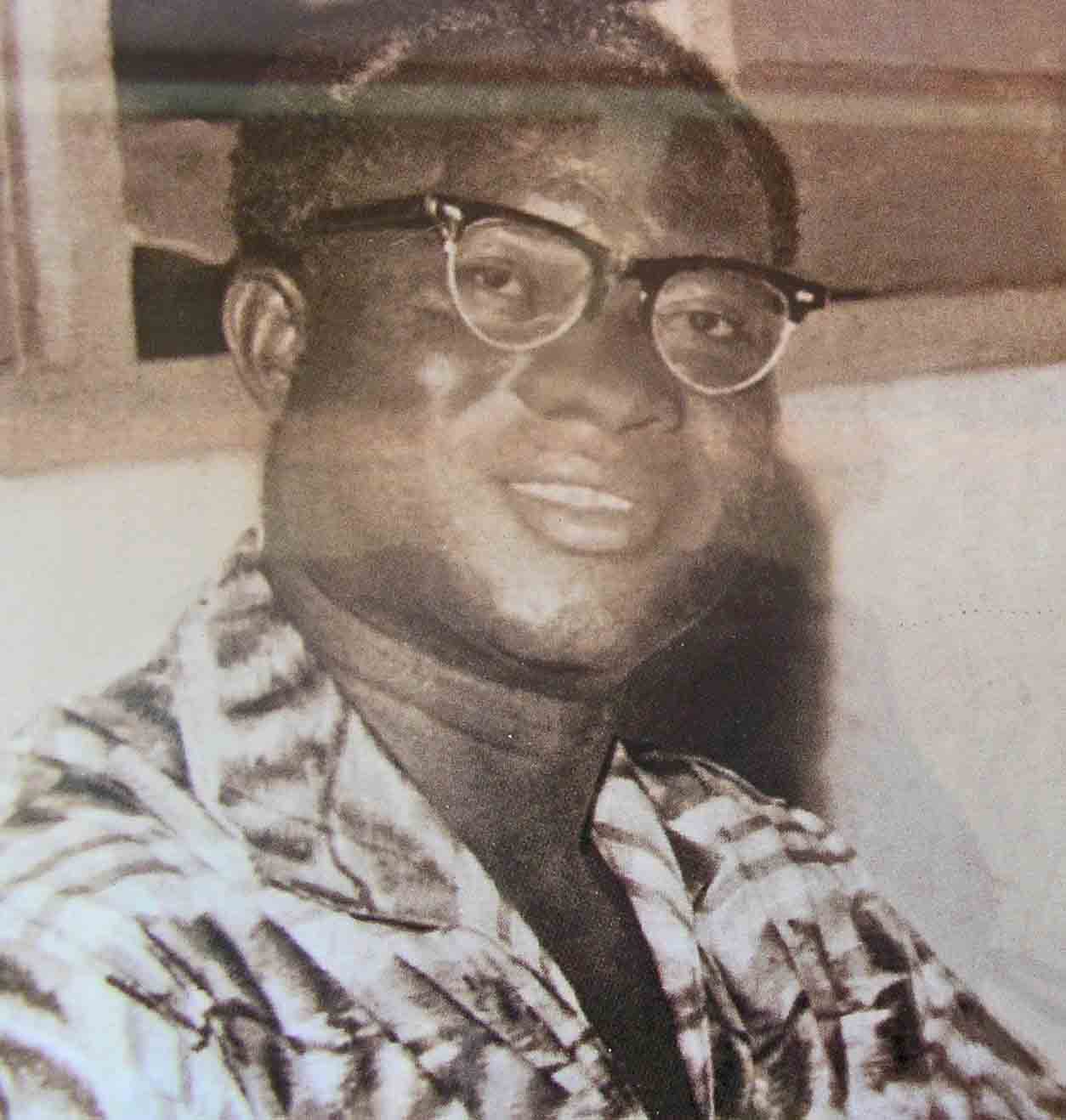 |
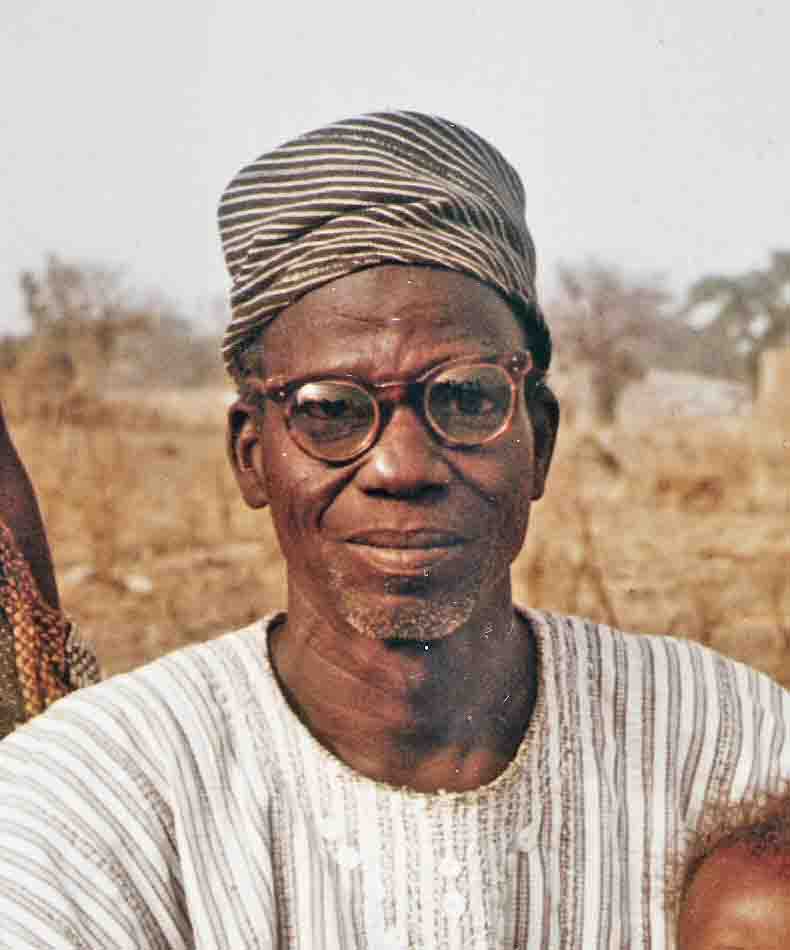 |
| Mr. A. Awulley | Mr. Leander Amoak |
One interesting aspect is the documentation on the members of staff with familiar names (see textbox). The late Sandemnaab, Sir Azantilow, is also mentioned frequently, and described as someone who was very interested in the school and the education of the pupils, as the British officer’s brief report below shows.
"5.11.1939, [British officer] arranged a football match between Sandema School and Navro Junior School and went over for it. ... Score 4 to 1 for Sandema... Sandemnab made an excellent host. What I like about him at these shows is that he gets up and moves about greeting people and talking to them and does not stay ... sitting in so-called state. He gave a sheep to the Chief of Chiana for the Navro boys which was of course much appreciated. He also showed the Chief of Chiana, who is a great friend of his, round the school...”
In R.G. Thomas’ book on “Education in Northern Ghana 1906-1940" (1975, p. 459), we find another story about the Sandemnab’s great interest in school education:
p. 459: ...At the Builsa Native Authority school, the chief of Sandema himself was said to sit at the feet of the head teacher to learn reading and writing,142 and at its opening in 1936 he made a speech in which he said that he was sorry that he had not had a European education, since without it he could not carry out his duties fully. “However,” he concluded, “I am the son of a Chief and of a Chief’s family so I know how to rule from the example of my fathers. These boys will make better chiefs than us old Chiefs because of their European education.”
Footnote 142: The young Sandem-nab, Azantilow, learned good English and has since been president of the Upper Region House of Chiefs in Ghana.
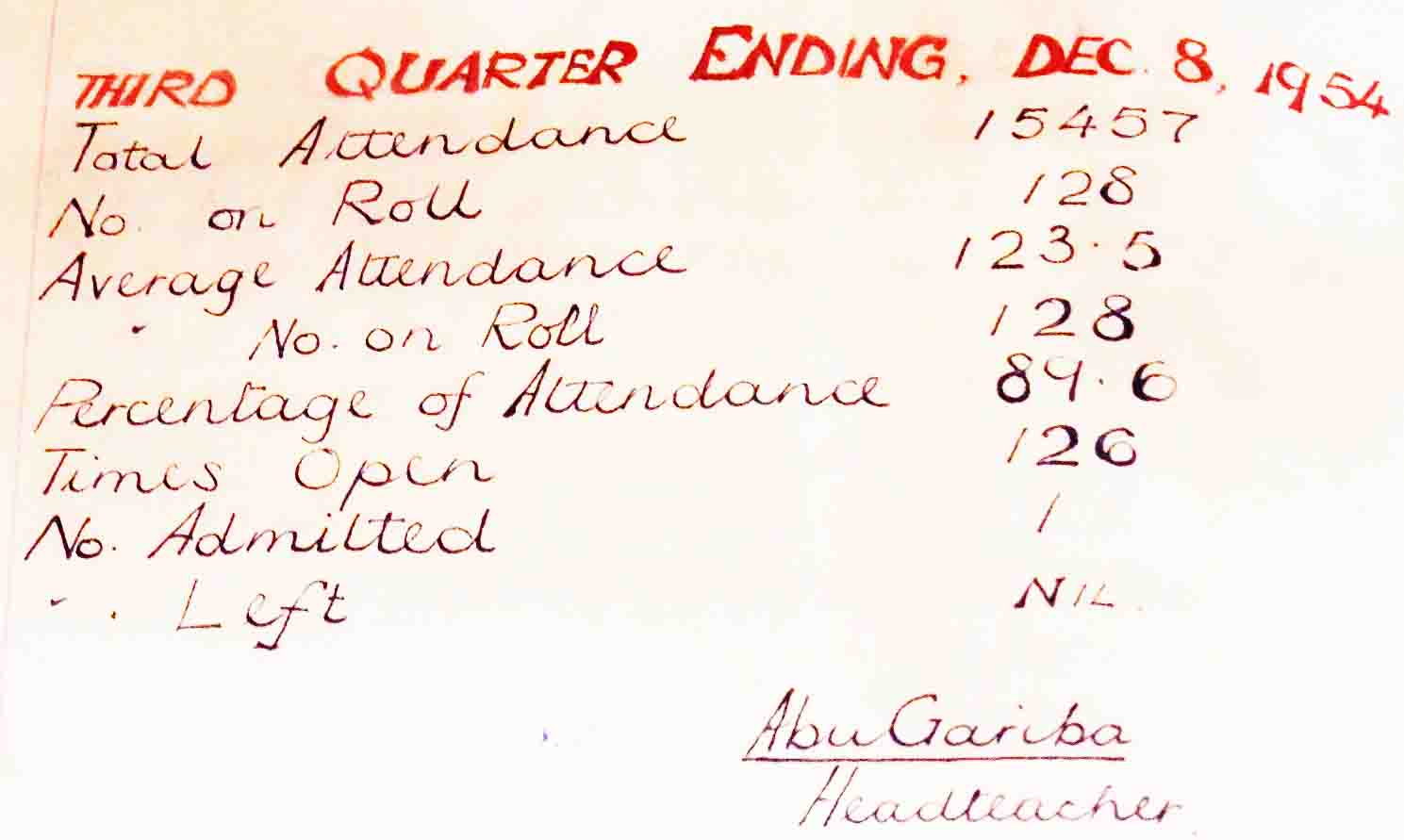 |
| Handwriting of Abu Gariba |
All the entries and reports of the log book are neatly hand written, by both the visiting inspectors (British) and the head-teachers, called Principal Teachers in the early years of the school. Personally, Mr. Abu Gariba’s handwriting is the best I’ve ever seen. I wish I could reproduce as many entries and reports as possible but, space would not allow it, apart from the fact that the digital copies of the pages I made are dark and cannot be sufficiently reproduced in print. I have, therefore, typed out and reproduced two reports which were written in 1949 and 1950 respectively. I hope their contents would give reader some insights into school life, organization and learning and teaching in our first school at the time. They are as follows:
Report on Sandema Native Authority Infant / Junior Boarding School, 12th / 13th September 1949, [by Walsh, British Education Officer).
Sandema Native Authority Infant / Junior Boarding School was inspected on 12th and 13th September 1949, the Sandem-nab being present on the morning of the first day. Staff and Enrolment: Mr. E.R. Ansogbe (Principal Teacher), Mr. J.A.A. Salaam, Mr. G.A. Asueme, Mr. A. Ayuekoruk, Mr. T. Bukare and Mr. A. Awulley (Crafts instructor). There are 85 boys and 24 girls making a total of 109. All the pupils, except 8 Southerners, are Builsas and 59 of them come from Sandema while the others are from outlying villages. The enrolment of girls remains difficult and the Sandemnab has promised his full assistance. The attendance of the pupils on the days of the inspection was good though it fluctuates considerably and dropped to 81.58% for the second quarter in 1949 due mainly to conjunctivitis and guinea worm cases in the school. There is a Native Authority dispensary situated near the school and this is used. The school diet provides plenty of vegetables from the school and contains adequate palm-oil. A goat is consumed every two days while the messing is supplemented by the products of the school farm. There has been an undue reliance on guinea-corn this year due mainly to the inability of the Native Authority to purchase foodstuffs, especially rice, when the market prices were low. A serious attempt should be made this year to buy rice in October /November when market prices are favourable. The Principal teacher holds an imprest of 10 Pounds for messing. School records registers and stock books are properly maintained as in the account for messing. The inspection report for 1948 should be entered in the log book.
(signed: Walsh, Education Officer)
Report on Sandema Infant / Junior Boarding School, 18th / 19th April 1950, [by R.N. Bryant, Education Officer]
The school was inspected on 18th and 19th April 1950, the Sandemnab being present on the first day and the school elders on the second. Staff: Mr. S. Ardayfio (Acting Principal Teacher), Mr. J.A. Salaam, Mr. G.A. Asueme, Mr. Anagela Akuri, Mr. Adansgeri Asoaal, Mr. Akolbelbisa Abaakisi, Mr. Leander Amoak (Arts and crafts). Mr. Ardayfio arrived from Winneba Training College in January 1950 to replace Mr. Amegbe who was transferred to Lawra. Mr. Anagela joined the staff from college at the same time, and Mr. [Leander] Amoak came from Chaana to replace Mr. Awulley. Mr. Salaam was sick in quarters with guinea-worm during the inspection.
Enrolment
|
Class |
Boys |
Girls |
Total |
Present at inspection |
|
Class I |
14 |
4 |
18 |
17 |
|
Class II |
11 |
6 |
17 |
17 |
|
Class III |
15 |
4 |
19 |
19 |
|
Standard I |
17 |
5 |
22 |
20 |
|
Standard II |
18 |
2 |
20 |
20 |
|
Standard III |
17 |
2 |
19 |
17 |
|
Total |
92 |
23 |
115 |
94 |
The new entrants are suitable aged, 67 of the children are from Sandema, 9 from Wiagha, 6 each from Kadema and Siniensi, 5 from Kanjarga, 3 each from Bidema (Gbedema) and Chuc[h]ulga and 1 each from Nwasi (Uwasi) and Bachonsi. All children are boarders.
Buildings
A good new two-classroom block has been built in stone with a second grass roof and was occupied in February this year. When funds are available, a third classroom should be added to it, giving each class a room of its own. The new block should be improved by whitewashing the inside wall and fixing a picture rail.
The old classroom is quite sound and has recently been whitewashed and had the defective windows replaced. The building of the new Principal Teacher’s quarters is proceeding slowly. It has now been roofed, but still requires plastering, and the out houses are only about 40% complete. Two teachers are living in a stone compound originally meant for boys, but not actually required by them, and two pupil teachers are living in an old swish compound. It will eventually be necessary to build two more teacher’s quarters and then demolish the swish compound and the present Principal Teacher’s house.
The children’s compounds are ample. They are well built and have good floors, but some of the thatched-roofs are defective. Some which had very recently been re-thatched in the girls’ and teachers’ compounds failed to keep out a brisk downpour on the first afternoon of inspection.
As a result of an order placed in Kumasi last year, furniture is now complete except for a teacher’s table and chair. The children’s chairs and tables are very suitable and the cost can be regarded as money well spent. It would probably be advisable to order the outstanding furniture for the day schools from Kumasi in view of the solitary carpenter’s extensive list of work on hand. The grounds are bare but well kept. Some hedge planting should be done near the classroom blocks.
The School farm
The farm has 12 acres, rather much to be farmed by the children and the two labourers at present. Last year’s report suggested that the size of the farm be reduced, but the Sandemnab does not wish this done. Three acres will therefore continue to be rotated and a fourth plot will be used to continue experiments with cotton and rice-growing. It may be necessary to engage extra labour but no further effort should be required of the children. There are four working bullocks, all in good working condition, and ploughing and manuring is now taking place. The wet season garden will be cultivated as before.
Records and stock
The school records are up to date and well kept. There is adequate stock of equipment.
Health and messing
The children were medically inspected last year. On returning to school this year as many as 65 children required treatment at Native Authority Dispensary nearby, the chief trouble being guinea-worm 14, conjunctivitis 14 and ulcers 7. At the time of inspection, the number of sick cases had been reduced to 21, but there are still 7 cases of guinea-worm undergoing treatment.
The meals were satisfactory. Palm-oil is supplied together with 2 goats weekly, and the Acting Principal has an imprest of £10 which is used to purchase vegetables etc. The cost of messing is estimated at 12 pence per month per child.
Classwork
Class I appear to have made slow progress, but that progress has been sound, and the children are patiently and pleasantly taught. Their reading is limited to a few two-letter words and in some cases there is still difficulty in recognizing the consonants. Number work is still in chalk but figuring is good and only three appear to lag behind the others in simple additions. Writing in chalk is well shaped but still restricted to simple letters. Drawing based on the day’s nature study lesson was very imaginative. Spoken English was very clear and was well taken by the teacher, but vocabulary is yet small. The teacher's notes were excellent and the progress chart was real.
Class II’s mental number work was very briskly taken but the written work was untidy, and not yet very accurate. It was noted that some of the questions set involved the 6x table although this has not yet been learnt according to the pupil teacher’s notes. Reading was hesitant with much mispronunciation, and the reading cards were badly written. Spoken English was clear and articulate, but the pupil teacher did not have any clear aim or system and his notes said “Ask pupils questions in general”. He was given brief instruction in the Spoken English scheme and its use, and he should watch the class I teacher at work, and then teach spoken English on the same lines, with a definite aim in every lesson. Four children were still writing in chalk and should be promoted to blue pencil as their writing was at least as good as many of the remainder whose letters were poorly shaped.
Class III was a better group. Number work was neat and mostly accurate. Reading was halting but clear comprehension was good, and there was a good response in vocabulary and spelling. Spoken English was briskly, almost fiercely taken, and the children’s articulation was clear and vocabulary adequate. Care should be taken not to pronounce such words as “works” as “weks”. Writing was handicapped by unsharpened pencils and the letters were not at all well shaped. Drawing was good, one child’s “village by night” showed remarkable sense of colour and composition. The teacher’s notes were rather untidy, and aims too general, but his progress charts were alive.
The standard of infant work has improved since last year when it was strongly criticized. Writing still needs more care. The two pupil teachers must realize that methods they remember from their senior school days are not usually suitable for infants. Their work needs closer supervision by the Acting Principal Teacher and they should be given opportunity to see the other teachers in action, particularly Class One and Standard One. The pupil teachers show much promise and there is no reason why they should not develop into good teachers provided they listen to advice tendered by the more experienced members of staff.
Standard I’s reading was well pronounced but expressionless, but questions on the matter were intelligently answered. A clumsy method was used for mental arithmetic, and children’s written work was rather untidy and of only fair accuracy. Writing had improved considerably during the year, and none was really bad.
Standard II was without its teacher who was sick in quarters, and was being looked after by the acting principal in addition to his own class. Arithmetic was of fair standard, and reading was very good. Although the children’s comprehension of the subject “SNOW” was naturally hazy. Oral English construction was well taken, the children being very keen and volunteering much correct information. Writing was quite good.
Standard III read fluently and their understanding of the matter read was fair, although some were rather surprisingly unable to explain the meaning of “anthill”. Arithmetic was neat and accurate. Written work was well done, and construction fairly good.
The new Acting Principal Teacher, having been recently on a course in England, has introduced many new ideas. He is quite conscious of the fact that many of them may need considerable modification before they become suitable for a school in the Northern Territories. The staff was urged to co-operate in trying out these new ideas, and appear to be doing so. Care must be taken that preoccupation with such novelties as puppets does not militate against progress with writing schemes, project work etc. and above all that the children’s time is not frittered away in experiments instead of the.
The new Arts and Crafts teacher [Mr. Leander Amoak] has organized his work with considerable skill, and his crafts room is a model of efficiency. Four types of loom are in action, leatherwork is producing useful articles and the girls do spinning, making pots, jugs and coolers, and basket work.
The infants make toys from guinea-corn stalks, many very modernistic in shape. There is a complete syllabus, every child has his own job to do, and a very pleasant habit of “singing while you work” has been established. The crafts building is not a thing of beauty but it is adequate provided it is re-thatched. The crafts teacher is to be congratulated on his excellent work.
General
This school has made definite progress during the past year. The standard of infants’ work has been raised and the furniture situation has been satisfactorily solved. The next requirements, in order of priority, are an extra classroom, two teachers’ quarters and a new art and craft block, but none is of pressing urgency. The Sandemnab continues to take a great personal interest in the school, but one looks in vain for any sign of useful work by the school committees.
(signed: R.N. Bryant, Education Officer)
Here are few brief comments found in the log book by the Acting Principal Teacher (Mr. S. Ardayfio):
24. 5. 50. Empire Day. The march past took place Commissioner was unable to come. The Sandemnab who would have taken it in the absence of the Assistant District Commissioner was away in Tamale. The Principal Teacher then took it. After the march past the Principal Teacher talked to the children about the Empire Day, how it came about and why it’s celebrated yearly and people about people who take part in it. There was a concert show at the end of the march past. This was enjoyed by the children and the next door neighbours of the school.
27. 5.50 The Principal Teacher left for Navrongo to collect teachers’ salaries and returned in the afternoon.
29. 5.50 Mr. G.A. Asueme who by permission accompanied the Sandemnab to Tamale on the 22nd returned last night.
8.6.50. General tidying up.
5.7.50 Children are engaged in the school farm for weeding and sowing.
2. Wiaga St. Francis Catholic Primary School
As in the case of Sandema Old Primary, the first log books of Wiaga Saint Francis Mission Day Primary School are also falling apart. The entries reproduced
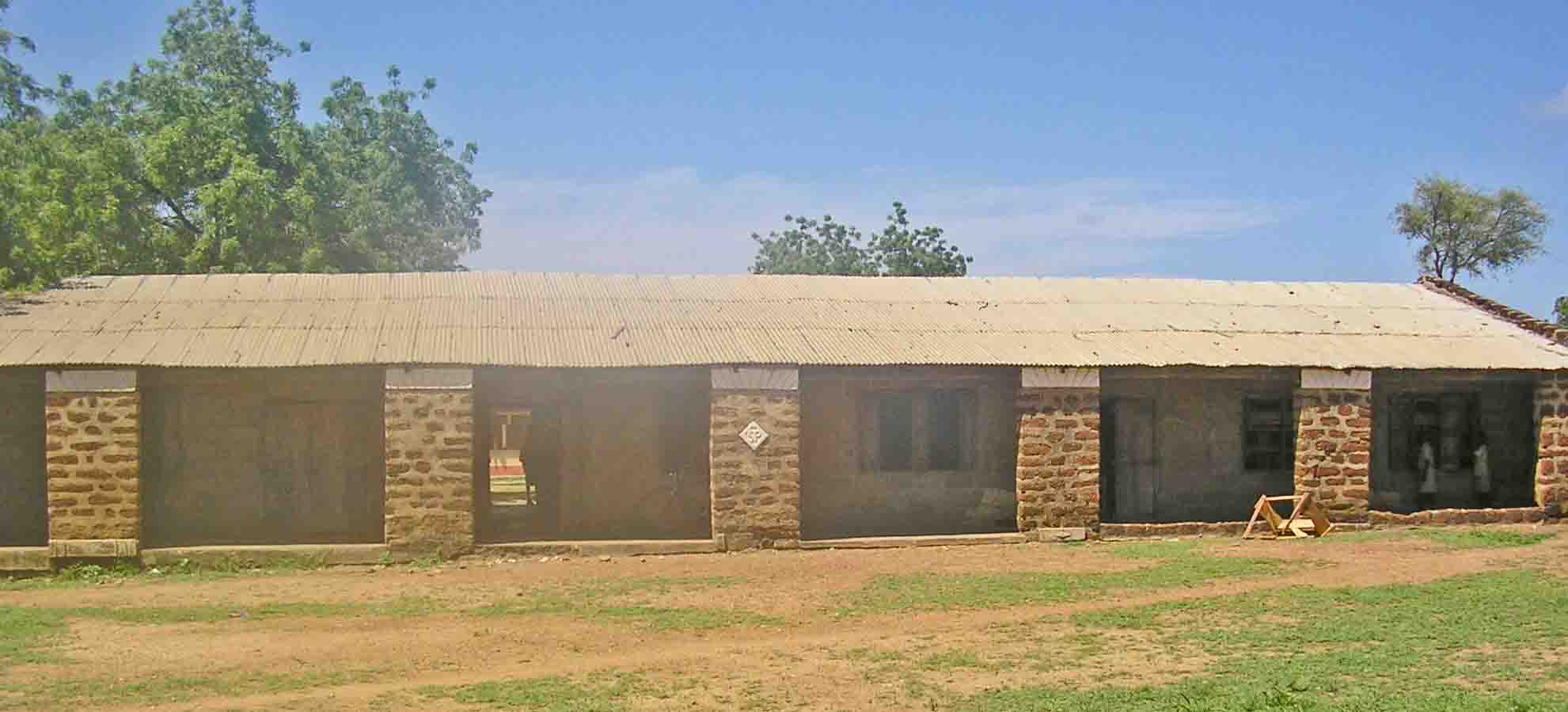 |
|
Original Seminary School Block, St. Francis |
here start from 1950. Most of them were written by Mr. Robert Ayomah, headteacher of the school at the time. When I visited the school in the company of Evans Atuick in July 2012, I was informed by the current headteacher of the school, Mr. Raymond Anyik, that St. Francis opened in 1931 [1930?] first as a minor seminary for training priests.
It was not until 1937 that it started as a full formal school for children. It is to be assumed that most of the Wiaga intelligentsia, teachers and civil servants, went to this school. They include Robert Ayomah (later headteacher of St. Francis Primary), Ataarem, Sulley, Akisikpak, Adaavari, Hilary Atuik (father of Evans A. Atuick, author of 3 articles of BULUK 7), Awogta (later Council Treasurer), Leander Amoak (later Arts and Crafts Teacher; photo: see above), Apientibadek, to mention a few.
Inspection Report [by Mr. H. R. Ayomah, headteacher]
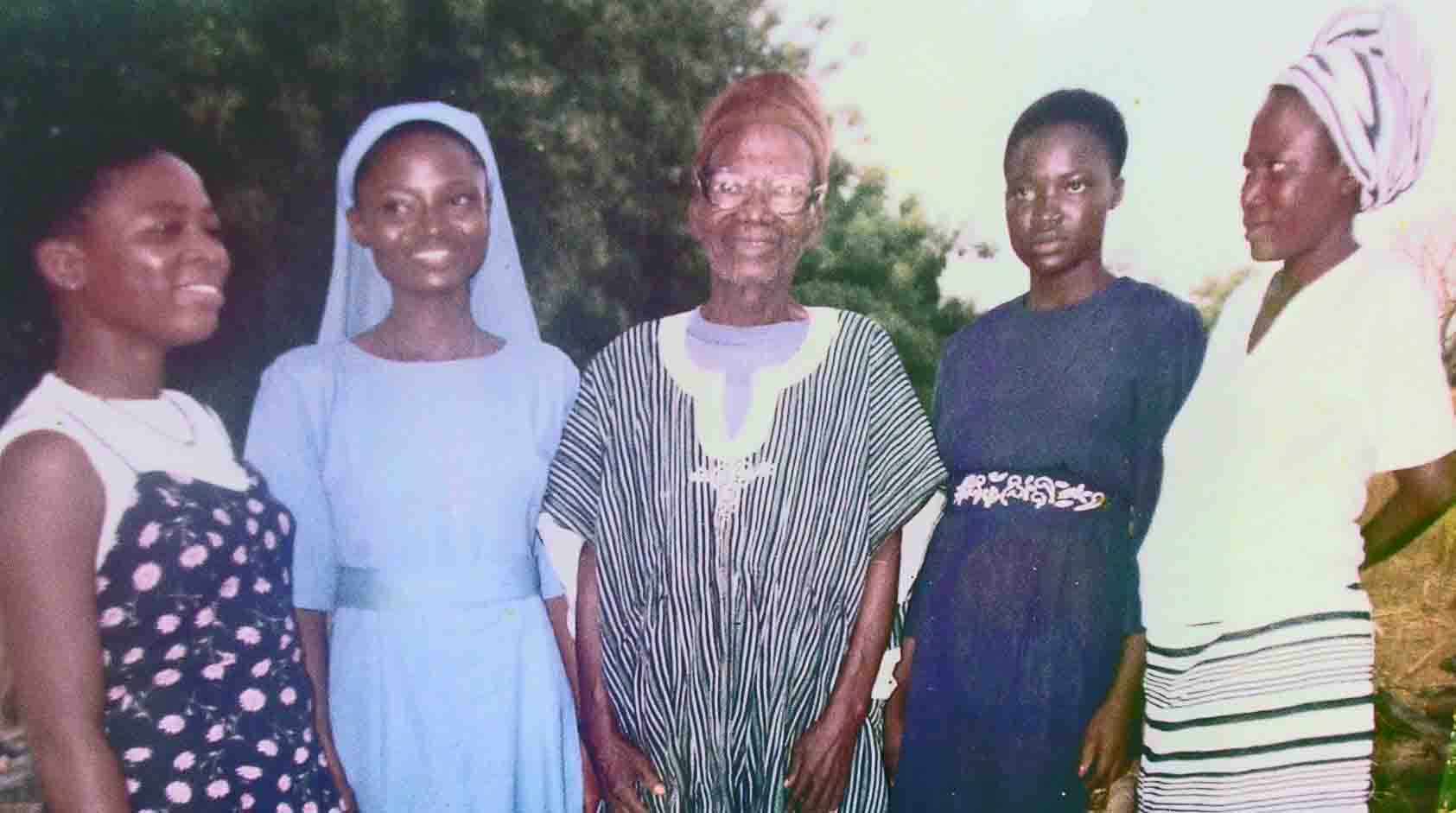 |
|
Mr. Robert Ayomah, headteacher of St. Francis in the 1950s with some of his daughters and granddaughters |
The non-government assisted Mission Day School of Wiaga was inspected on 14th April 1950, the Manager, Rev. Father Gagnon being present. There are 22 boys and 5 girls on roll in Class 1 of whom 22 were present. Their teacher is Mr. Alexis Alangea from Bolgatanga. It was intended to start with 38 children but enrolment, as in other parts of Builsa, was difficult. Most of the children are from Wiaga but Christian parents from other places have sent a few children; 2 from Siniensi, and 1 each from Sandema, Bidema (Gbedema), Fumbisi and Chulchulga. Together with 3 others from Wiaga, the 6 children board at the Mission station in an old compound which has been renovated. All the children cannot be regarded as suitable for class 1. A few may be as young as 7 years but most of them are 8, 9 or 10 years old. One of them insists that he is 11 years old although he doesn’t look it. Average attendance was 91% during the first quarter, attendance being affected by an outbreak of measles in March.
Buildings
The new building is incomplete but a third classroom plus office is ready for roofing, and roofing timbers are being fixed. The block has verandahs and the outer walls and pillars are cut out of stone. Plastering remains to be done for the interior walls and floors. The roof will be of iron sheets. The building is beautifully sited and a good playing field already exists. A new latrine is being dug, the children meanwhile using an old one attached to the boarding compound. There is a good well just behind this compound. The school garden has already been fenced but it is rather too big to be farmed by children until school expands.
Health
The children present were exceptionally healthy and lively and any first aid required can be had at the Mission dispensary.
Meals
A cooked meal, millet and groundnut soup, is provided at midday for all the children.
Furniture
There are only 7 double tables and 20 stools but new furniture is to be made for the new block. The teacher has a table and a chair and convertible packing cases make serviceable cupboards.
Stock
There is no admission register but all other records are well kept. Syllabus and timetable are satisfactory. No fees are charged and the present books are issued for free.
Lessons
The class teacher has difficulties to contend with. He is teaching in a strange language (his own is Nankani), but he appears to be understood by the children who have attended vernacular reading classes while the rest are absolute beginners. Trying to cater for these groups has led to work below the average among the beginners. It is inevitable that if the beginners are to be properly taught, the others will more or less have to mark time for a year. In [teaching] Numbers the ex-vernacular reading class has acquired great proficiency and has little to learn in class one. 6 others are capable of adding and subtracting single figure numbers in pencil. 3 are doing the components of 5 in chalk and 3 others are still trying to write the numbers in chalk. In the absence of free arm boards all wrote on the blackboard. The figures made even by the A group were extremely large and not well shaped, and the teacher wrote in three different ways in his blackboard work.
Vernacular reading was the signal for a prolonged quarrel about cards and reading books. Group A read a biblical reader with ease, and the others recognized the vowels but were very confused about consonants due to these not having been taught separately before being used in two-letter words. A few children had advanced in diagraphs and read quite well.
Spoken English consisted of class repetition with all shouting at the top of their voices. When the children were tested individually by the inspector, it was evident that the bulk of them did not understand the simplest questions, nor did they understand the sentences they themselves had repeated.
In vernacular composition Group A was sufficiently advanced but there were reading errors due to the language problems the teacher had. The teacher is doing his best but his efforts are often based on unsound methods. He is advised to spend less time with the Group A children and concentrate on improved figures and writing and more individual work in spoken English with the beginners.
Other entries in the log book include some of the following:
9.11.50 : 3 tins of sweet potatoes are dug from the garden and cooked for the children.
25.11.50: We begin the year ending exams. The Superior of Navrongo Mission arrives this afternoon and will visit the school this morning accompanying His Lordship the Bishop and the Superior General of the White Sisters in Canada.
8.1.51: 20 children of last year Class One are too big for Class Two and have therefore left.
My comments:
The information we gather from the log books of both schools as reproduced here is definitely of interest to teachers, parents and all stakeholders in educational efforts in Bulsa. What can we learn from the past? Have educational efforts since the introduction of formal education met the needs of our communities in terms of development? If yes, in which ways, and if no, what can we do to make education more inclusive, functioning as the viable instrument of social and community development that it ought and should be? It is my hope that with time we will have the opportunity to discuss the issue in BMY’s Facebook forum and making recommendations, where necessary, to the appropriate organs.
References
BULUK 3 (2003): Kröger, Franz: Going to a Bulsa School....[on p. 21:], p. 21 (foundation dates of some Bulsa schools).
BULUK 4 (2005): The Beginning of Christian Missions... p. 44-48 (p. 46f: first schools in Wiaga)
BULUK 7 (2013): Ayarik, Ghanatta: Eric Akanpaanab Ayaric recalls his school days in the 1930s and 1940s.
MATERIALIEN: Asueme (Life-Story)
Der, Benedict G. (2001): Christian Mission and the Expansion of Western Education in Northern Ghana, 1906-1975. In: Yakubu Saaka (Ed.): Regionalism and Public Policy in Northern Ghana. New York et. al.
Thomas, Roger G.: Education in Northern Ghana, 1906-1940 (1975)